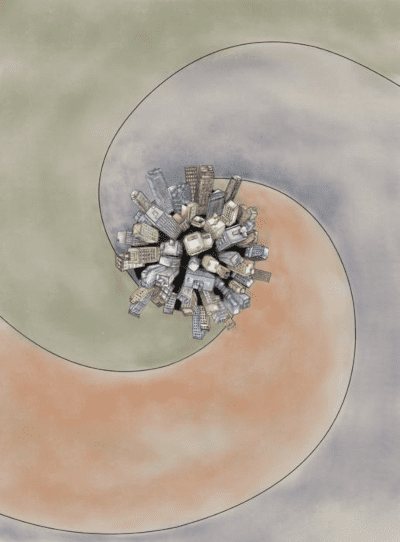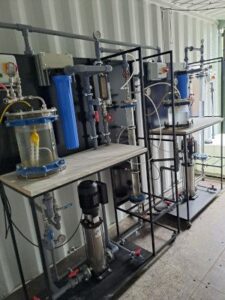

A recent study attempts to predict the future state of urban ecosystems, and suggests the need for a new science of waste.
Living systems have evolved to reconstitute waste — creatures like dung beetles fill an ecological niche of breaking down other organisms’ faeces — but waste is a problem that still plagues human systems.
As the world population continues to grow and rapidly urbanize — two-thirds of humans will be city dwellers by 2050, according to the United Nations — our waste is driving a mounting worldwide crisis. Microplastics blanket the planet and infiltrate our bodies, wastewater pollutes our waterways, and greenhouse gas emissions are driving global climate change.
“We as a society tend to ignore the unpleasant side of our production,” says Mingzhen Lu, an Assistant Professor at New York University and former SFI Omidyar Complexity Fellow.
Lu and SFI Professor Chris Kempes are co-corresponding authors on a new paper published in Nature Cities that explores waste production as a function of urban systems.
“The key question is whether waste is produced more or less efficiently as systems scale up, and how big a recycling burden there is as a consequence,” says Kempes.
To address this question, the authors used scaling theory to analyze waste products — municipal solid waste, wastewater, and greenhouse gas emissions — from more than one thousand cities around the world. Scaling theory has been used in biology to describe how organism physiology changes with body mass, and it proved relevant for understanding how waste production scales with the growth of a city.
“Scaling theory allowed us to extract overarching broad stroke patterns and transcend the individuality of each city,” said Lu.
The resulting patterns show distinct differences in waste production as cities grow. Solid waste scales linearly — because it is tied to individual consumption, it increases at the same rate as population growth. In contrast, wastewater production scales superlinearly while emissions scale sub-linearly. In other words, bigger cities contribute disproportionately more liquid waste than smaller cities, but expel fewer greenhouse gasses. The results suggest an economy of scale for emissions as growth typically brings more efficient energy and transportation infrastructure, but a diseconomy for liquid waste.
Cities tend to deviate from the universal scaling law as they grow wealthier. Cities with higher per-capita GDP generate more waste across the board, which underscores the relationship between waste generation and economic growth.
The findings emphasize the need for a new science of waste that can help predict the future state of urban ecosystems and inform policies to reduce waste and enhance sustainability.
“Fungi figured out how to decompose lignin waste from trees and created sustainable ecosystems that have lasted hundreds of million years,” says Lu. “We take it in and throw it away — we can no longer overlook waste from our societies.”
Read the paper “Worldwide scaling of waste generation in urban systems” in Nature Cities (January 17, 2024) DOI: https://doi.org/10.1038/s44284-023-00021-5
- SEO Powered Content & PR Distribution. Get Amplified Today.
- PlatoData.Network Vertical Generative Ai. Empower Yourself. Access Here.
- PlatoAiStream. Web3 Intelligence. Knowledge Amplified. Access Here.
- PlatoESG. Carbon, CleanTech, Energy, Environment, Solar, Waste Management. Access Here.
- PlatoHealth. Biotech and Clinical Trials Intelligence. Access Here.
- Source: https://envirotecmagazine.com/2024/01/24/the-natural-world-should-inspire-a-new-science-of-waste/
- :has
- :is
- $UP
- 17
- 2024
- 2050
- 300
- 400
- a
- According
- accordingly
- across
- address
- allowed
- an
- analyze
- and
- ARE
- around
- AS
- Assistant
- At
- Attempts
- authors
- away
- banners
- BE
- because
- been
- between
- Big
- bigger
- biology
- board
- bodies
- body
- Breaking
- Brings
- broad
- burden
- but
- by
- CAN
- change
- Changes
- Cities
- City
- Climate
- Climate change
- complexity
- consequence
- consumption
- content
- continues
- contrast
- contribute
- created
- creatures
- credit
- crisis
- describe
- deviate
- differences
- disabled
- distinct
- does
- down
- driving
- each
- Ecological
- Economic
- Economic growth
- economy
- Ecosystems
- efficient
- efficiently
- either
- Emissions
- emphasize
- energy
- enhance
- Envirotec
- evolved
- explores
- extract
- fellow
- fewer
- figured
- fill
- findings
- For
- Former
- from
- function
- future
- GAS
- GDP
- generate
- generation
- Global
- greenhouse gas
- Greenhouse gas emissions
- Grow
- Growth
- Have
- help
- High
- higher
- How
- How To
- HTML
- HTTPS
- human
- Humans
- Hundreds
- ignore
- image
- in
- In other
- Increases
- individual
- individuality
- inform
- Infrastructure
- IT
- January
- Key
- Law
- less
- like
- Liquid
- longer
- Mass
- million
- more
- more efficient
- municipal
- Nations
- Nature
- Need
- New
- New York
- New York University
- niche
- no
- None
- NYU
- of
- ONE
- or
- Other
- our
- out
- overarching
- Paper
- patterns
- Plagues
- planet
- plato
- Plato Data Intelligence
- PlatoData
- policies
- population
- predict
- Problem
- Produced
- Production
- Products
- Professor
- proved
- published
- qualified
- question
- rapidly
- Rate
- recent
- recycling
- reduce
- reduce waste
- relationship
- relevant
- resulting
- Results
- Said
- same
- says
- Scale
- scales
- scaling
- Science
- show
- side
- Size
- smaller
- Society
- solid
- State
- Still
- Study
- suggest
- Suggests
- Sustainability
- sustainable
- Systems
- Take
- tend
- than
- that
- The
- The Future
- the world
- theory
- There.
- they
- this
- thousand
- three
- Tied
- to
- transportation
- Trees
- two-thirds
- types
- typically
- underscores
- understanding
- United
- united nations
- Universal
- university
- urban
- us
- used
- Waste
- we
- whether
- which
- while
- will
- with
- words
- world
- worldwide
- years
- york
- zephyrnet








